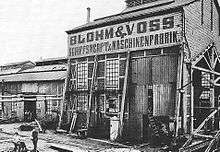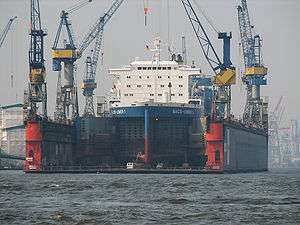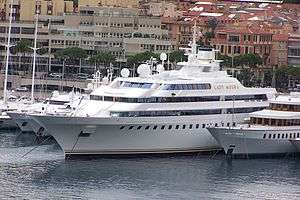Blohm+Voss
 | |
| Private, GmbH | |
| Industry | Shipbuilding |
| Founded | 1877 |
| Founder | Hermann Blohm and Ernst Voss |
| Headquarters | Hamburg, Germany |
| Products | Ships, Offshore Oil and Gas Installations, Aircraft. |
| Parent | Lürssen |
| Website | blohmvoss.com |
Blohm+Voss (B+V), also written historically as Blohm & Voss, Blohm und Voß etc, is a German shipbuilding and engineering company, Founded in 1877, its most famous product is the World War II battleship Bismarck.
B+V is currently a subsidiary of Lürssen and continues to supply both the military and civil markets. The company also carries out related activities, managing a dockyard and maintenance and repair of large cruise ships. It also supplies Offshore Oil and Gas Installations.
In the 1930s its owners established the Hamburger Flugzeugbau which built aircraft before and during World War II and, shortly before the outbreak of war, became a subsidiary of its parent company and adopted its name.
History
Early years


Blohm & Voss was founded on 5 April 1877, by Hermann Blohm and Ernst Voss (or Voß) as a general partnership. It established a shipyard on the island of Kuhwerder, near the Free and Hanseatic City of Hamburg, covering 15,000 m² with 250 m of water frontage and three building berths, two suitable for ships of up to 100 metres length. The company name was shown with the ampersand, as B&V, until 1955.
The company's initial products were steel-hulled sailing ships designed for long sea voyages. At that time steamships had a relatively short range, while many of the advantages of steel construction still applied to sailing ships as much as to steam. The company built its first steamship in 1900, while still continuing to build sailing ships until the late 1930s.
The Nazi era, 1933-1945
When Hermann Blohm died, his two sons Rudolf and Walther took over. Ernst Voss left soon afterwards. By this time the company was in financial crisis, so the Blohm brothers diversified into aircraft, setting up the Hamburger Flugzeugbau (see below) in the summer of 1933.[1]
With the rise of the Nazi Party to power in 1933, Germany began to rearm and both companies became increasingly involved in the programme.
From July 1944 to April 1945 the company used inmates of its own concentration subcamp at its shipyard in Hamburg-Steinwerder, a subcamp of Neuengamme concentration camp.[2] A memorial stands on the site of the camp and the company continues to pay an undisclosed amount to the Fund for Compensation of Forced Laborers.[3]
Postwar
The company has built ships and other large machinery continuously for 125 years, despite being almost completely demolished by the end of World War II. It now builds warships both for the German Navy and for export (see MEKO), as well as oil drilling equipment and ships for numerous commercial customers. It administers the Elbe 17 dry dock at Hamburg. The company's logo is now a simple dark blue rectangle with rounded corners bearing the white letters "Blohm+Voss".
For a time the company was, along with Howaldtswerke at Kiel and Nordseewerke at Emden, a subsidiary of ThyssenKrupp Marine Systems. In 2011 ThyssenKrupp agreed the sale of Blohm + Voss' civil shipbuilding division to British investment company STAR Capital Partners.[4][5]
On September 28, 2016, it was announced that Lürssen would acquire Blohm + Voss from STAR Capital Partners, in a long-term partnership.[6] Regulatory approval was given in October 2016.[7] In April 2017 the company was poor financial condition and announced that it would be laying off about 300 employees.[8]
Hamburger Flugzeugbau
In 1933 Blohm & Voss was suffering a financial crisis from lack of work. Its owners, brothers Rudolf and Walther Blohm, decided to diversify into aircraft manufacture, believing that there would soon be a market for all-metal, long-range flying boats, especially with the German state airline Deutsche Luft Hansa. They also felt that their experience with all-metal marine construction would prove an advantage. They formed the Hamburger Flugzeugbau that summer.[9][1]
Most of the aircraft built by HFB/B&V would in fact be other companies' designs and major subassemblies, contracted under license, including tens of thousands of aircraft each for Dornier, Heinkel, Junkers and Messerschmitt.[1] Alongside its volume manufacturing the company also maintained its own design office and workshops which continued to develop and build new types throughout the company's life. The first planes it produced were designated with the official RLM company code "Ha".
The aircraft produced by Hamburger Flugzeugbau were still commonly associated with Blohm & Voss and this was causing confusion, so in September 1937 Hamburger Flugzeugbau was renamed Abteilung Flugzeugbau der Schiffswerft Blohm & Voss and the RLM changed its company code to "BV".[10]
Its most significant designs were flying boats, mainly used by the Luftwaffe for maritime patrol and reconnaissance. Most numerous was the BV 138 Seedrache (initiated as the Ha 138), a twin-boom trimotor, while the BV 222 Wiking was much larger. Largest of all was the BV 238 prototype, the largest aircraft built by any of the Axis forces. Other notable types include the asymmetric BV 141, which was built in moderate numbers but did not enter production.
At the end of the war, aircraft production was shut down. Hamburger Flugzeugbau GmBH (HFB) would re-emerge in 1956, still under the ownership of Walther Blohm but no longer connected to B+V. Under further changes of ownership and company name, it continues to build aircraft.[11]
Ships and maritime
Blohm & Voss was established in the days of sail and did not produce a notable steamship until 1900. Notable ships built by Blohm & Voss include:
Tall ships
- Flying P-Liners, including Petschili (1903), Pamir (1905), Passat (1911), Peking (1911), Pola (1916) and Priwall (1917)
- Prinzess Eitel Friedrich (1909) (later Dar Pomorza)
- The three-mast barques and school ships of the Gorch Fock class, between 1933 and 1938.
Ocean liners and other passenger ships
- Prinzessin Victoria Luise (1900), a Hamburg America Line ship, the first ship built exclusively for cruising
- RMS Majestic (1914), a White Star Line liner and the largest ship in the world until the completion of the Normandie in 1935
- SS Leviathan (1914), a United States Lines liner and sistership to the RMS Majestic. Scrapped in 1938.
- SS Cap Arcona (1927), a Hamburg Süd liner sunk with great loss of life near the end of the Second World War
- SS Monte Cervantes (1927), a Hamburg Süd liner lost near Tierra del Fuego in 1930
- SS Europa (1928), a Norddeutscher Lloyd liner and Blue Riband winner
- MV Monte Rosa (1930), a passenger liner and cruise ship that would become better known as the troopship Empire Windrush
- SS Potsdam (1935), a Norddeutscher Lloyd turbo-electric liner that served as an Allied troopship and then the Pakistani pilgrim ship Safina-E-Hujjaj.
- TS Pretoria (1936) and TS Windhuk (1936), Deutsche Ost-Afrika Linie passenger cargo liners.
- MV Wilhelm Gustloff (1937), Kraft durch Freude (Strength Through Joy) cruise ship and the world's worst maritime disaster when she was sunk towards the end of the Second World War
- MV Aurora (1955) As the Wappen Von Hamburg. It was the first luxury liner to be built after World War II.
- MV Explorer (2001), used by the Semester at Sea university study abroad program
Private yachts

- A – 119 m (390 ft) owned by Russian billionaire Andrey Melnichenko
- Dubai – owned by the ruler of the Emirate of Dubai and the Prime Minister of the United Arab Emirates, Sheikh Mohammed bin Rashid Al Maktoum
- Eclipse – the second-largest private yacht, owned by Russian billionaire Roman Abramovich.
- Enigma – a yacht ordered by Azcarraga, later owned by Larry Ellison and Aidan Barcaly.
- Grille – built as the German state yacht (1935), converted to minelayer at the beginning of World War II, later reconverted to state yacht of Nazi Germany, Hitler's official maritime conveyance.
- Lady Moura – owned by Saudi billionaire Dr Nasser al-Rashid. [12]
- MV Savarona – built for an American heiress in 1931. Later the Turkish Presidential yacht and now a charter yacht. Still among the largest yachts, at 446 feet (136 m) long.
Warships of World War I
- SMS Glyndwr, light seaplane carrier converted from a merchant ship
- SMS Von der Tann, battlecruiser
- SMS Goeben, battlecruiser
- SMS Moltke, battlecruiser
- SMS Scharnhorst, armoured cruiser
- SMS Seydlitz and SMS Derfflinger, battlecruisers that were heavily damaged in the Battle of Jutland; both stayed afloat and brought their crews home.
Warships of World War II
- Admiral Hipper, heavy cruiser
- Bismarck, battleship
- Many Type VII, Type XVII, Type XXI and Type XXVI U-boats
Modern warships
- Aradu (F89), a MEKO 360H1 frigate for the Nigerian Navy
- Almirante Brown-class (MEKO 360H2) destroyers for the Argentine Navy
- Rheinland-Pfalz (F209), a Bremen-class frigate
- Brandenburg (F215), the first Brandenburg-class frigate
- Sachsen (F219), the first Sachsen-class frigate
- Vasco da Gama (F330), a Vasco da Gama-class (MEKO 200PN) frigate for the Portuguese Navy
- Z28-class patrol boats for the Argentine Coast Guard
Oil and offshore
During the postwar years, B+V built oil rigs and developed a market for other offshore products such as support ships and pipelines.[13][14][15]
References
Notes
- 1 2 3 Pohlmann (1979).
- ↑ The camp Blohm & Voss is listed as No. 550 Hamburg in the official German list Archived April 23, 2009, at the Wayback Machine. (List in German)
- ↑ Herbert Diercks, Der Hamburger Hafen im Nationalsozialismus, 2008
- ↑ Bryant, Chris. "ThyssenKrupp sells ‘mega-yacht’ division". FT.com. Financial Times Limited. Retrieved 12 December 2011.
- ↑ "STAR Capital Partners buys Blohm & Voss’ civil business". SuperYachtTimes.com. SuperYachtTimes.com. Retrieved 12 December 2011.
- ↑ "Breaking news: Lürssen acquires Blohm + Voss". superyachttimes.com. 28 September 2016. Retrieved 28 September 2016.
- ↑ German Fair Trade Commission approves Blohm+Voss Acquisition, B+V web site, 31 October 2016. (Retrieved 17 April 2017).
- ↑ "Dramatic year for German shipbuilding". The Motorship. 20 April 2017.
- ↑ Amtmann (1998)
- ↑ B+V Geschichte v. 1933-1938 -Die Rüstungskonjunktur ab 1933
- ↑ Pohlmann (1979), 1982 edition, Page 242.
- ↑ http://www.superyachtfan.com/superyacht_lady_moura.html
- ↑ Cape Town shipyard busy with Scarabeo 3 upgrades, MarineLog (retrieved 26 April 2017)
- ↑ Semi submersible drill rig Chris Chenery, Oil Rig Photos (retrieved 26 April 2017)
- ↑ Offshore Units, Blohm+Voss (retrieved 26 April 2017)
Bibliography
- Meyhoff, Andreas. Blohm & Voss im »Dritten Reich«, Eine Hamburger Großwerft zwischen Geschäft und Politik (Hamburger Beiträge zur Sozial- und Zeitgeschichte, Band 38) (in German). Hamburg, Germany: Forschungsstelle für Zeitgeschichte in Hamburg, 2001. ISBN 3-89244-916-3.
- Pohlmann, Hermann. 'Chronik Eines Flugzeugwerkes 1932-1945. B&V - Blohm & Voss Hamburg - HFB Hamburger Flugzeugbau (in German). Motor Buch Verlag, 1979 ISBN 3-87943-624-X.
- Prager, Hans Georg and Bishop, Frederick A.(Transl.). Blohm + Voss: Ships and Machinery for the World. London: Brassey's Publishers Limited, 1977. ISBN 0-904609-14-6.
- Witthöft, Hans J. Tradition und Fortschritt - 125 Jahre Blohm + Voss (in German). Koehlers Verlag, 2002. ISBN 3-7822-0847-1.
External links
| Wikimedia Commons has media related to Blohm+Voss. |
- Official website
- Company history (in English)
- Company history (in German)
- Aviso Grille - Hitler's War Yacht - Revel Barker
- Wehrmacht History
- Luft '46 - Blohm + Voss
- 3 original wartime color slides showing the 222 Viking in 1942
